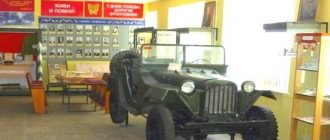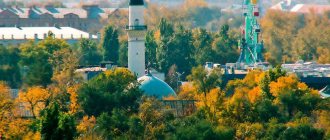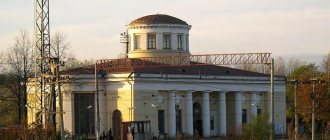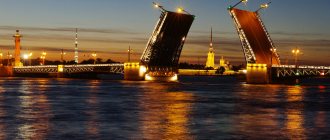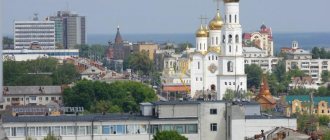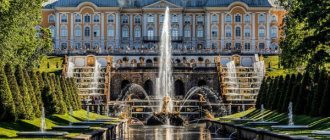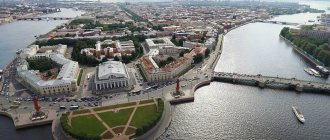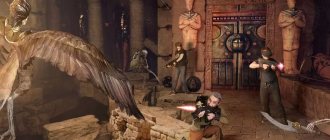As a rule, tourists coming to St. Petersburg begin their acquaintance with the city with the most famous historical sites. This list, in particular, includes the Alexander Column and Palace Square, the Winter Palace and the Hermitage, the Smolny and Bronze Horseman, Nevsky Prospekt, Mikhailovsky Castle, etc. Of course, travelers strive to see all these places and monuments first. After all, such sights are a kind of calling card of the Northern capital.
In the city you can find places that deserve no less attention and at the same time are unique, inimitable and attractive, especially for young people. Such objects are not included on maps of popular tourist routes, considering them to be of secondary importance. But they are all also quite interesting. So where should young people go in St. Petersburg to get a complete picture of their impressions of the city?
The oldest rock store in St. Petersburg
Ligovsky Prospekt, 47 (metro station Ploshchad Vosstaniya)
Photo: Vasilisa Tarunova
One of the moods of St. Petersburg is Russian rock. Therefore, it will be symbolic if the route begins at the legendary Castle Rock rock paraphernalia store, which has been operating opposite the Moskovsky Station for 19 years. Informal youth gathered here until the owner promised the locals peace and tranquility. Among the clients are Yuri Shevchuk, Boris Grebenshchikov, Sergei “Chizh” Chigrakov, Oleg Garkusha and other famous musicians. In addition to goods with appropriate rock paraphernalia, real artifacts are exhibited here: handprints, autographs, personal belongings of stars. For example, the cloak of Mikhail Gorshenev from the group “King and the Clown” and the concert costume of Ilya Chert from “Pilot”.
Circus
What objects of St. Petersburg are most popular among young people? One of those that is on their list is the circus that can be found on the Fontanka. This is one of the oldest establishments of this kind in Russia. It opened in 1877.
The St. Petersburg Circus on Fontanka, whose poster is very interesting and varied, is a popular place to visit not only for guests of the city, but also for its residents. In addition, here you have the opportunity to visit the museum, which was opened back in 1928. Its exhibits tell about the history of circus art. To date, 130 different objects have been collected here, which can tell visitors a lot of interesting things about this branch of culture.
Apartment House Baka
Kirochnaya street, 24 (metro Chernyshevskaya)
Photo: Vasilisa Tarunova
Not far from the pavilion of the Chernyshevskaya station there is an impressive house built in 1904-1905 for the publisher of the Rech newspaper Yulian Bak. This building has an “intricate” architecture, a richly decorated facade, open balconies, labyrinths of staircases and airy galleries that connect the wings to the main building on the second and fifth floors. Apartment numbering can drive even experienced couriers crazy. For example, after apartment No. 9, No. 34 suddenly appears. This is the result of numerous redevelopments of manor apartments into communal compartments, and then again into separate apartments. Enter the entrance on one street and try to exit on another.
The music store where the movie "Brother" was filmed
Kirochnaya street, 8 (metro Chernyshevskaya)
Photo: Vasilisa Tarunova
Incredibly, the music store where Danila Bagrov wanted to buy Nautilus still exists. In St. Petersburg, several addresses are attributed to him, but the filming took place in this courtyard on Kirochnaya. Go down the stairs, go to the record counter and ask: “Do you have the Wings of Nautilus?” And if the seller is in a good mood, he will answer you: “No, they sell it out very quickly. But you come again."
Apartment house of three Benois
Kamennoostrovsky prospect, 26—28 (metro station Petrogradskaya)
Photo: ru.wikipedia.org
One of the three most famous apartment buildings in the northern capital (together with the Tolstoy House and the Baka House), built according to the design of the Benois brothers in 1912. The gigantic building can be called a metaphor for St. Petersburg: in one wing there are elite multi-room apartments, in the other there are classic communal apartments, and the third was destroyed by looters. Walk through the labyrinth of twelve well buildings that connect all the buildings of the giant complex. At the beginning of the 20th century, this building served as a model for the improvement of apartment buildings. It was equipped to the innovative standards of the time with built-in elevators, a steam heating system, its own power plant, laundry, incinerator, snow melter and even telephones. Famous party leaders, singers, artists and composers, for example Dmitry Shostakovich, lived in the house.
Summer garden
Many young tourists strive to get to the park created by the tireless Peter the Great. Just from the description of the Summer Garden in St. Petersburg, it becomes clear that you definitely need to set aside time to visit it.
The most accessible entertainment here is walking along the paths of the park and visiting the Petrovsky Palace. Tourists also like to take pictures against the backdrop of beautiful sculptures and fountains, relaxing in the Coffee House with a cup of aromatic invigorating drink.
The landscape of this place corresponds to the style of the French Park. These are symmetrical alleys, which, together with carefully trimmed plantings, represent entire labyrinths of paths. Walking along the paths, park guests can admire the elegant sculptures standing along them. Peter the Great himself brought them from Italy especially for the Summer Garden. These elegant sculptures are nothing more than restored copies of ancient compositions. In addition to the statues, park guests can admire the tall trees growing here.
There are several beautifully designed fountains on the territory of the Summer Garden. There are also figured lawns here, they are decorated with intricate flowerpots. Judging by the reviews of tourists, benches, gazebos and a picturesque pond leave a pleasant impression of the park. Guests of the garden examine with interest the greenhouse and poultry house located on the territory.
The rectangular two-story building with a high roof also attracts the attention of travelers. This is a small Summer Palace that belonged to Peter the Great. Today the building is presented in its original form. Its facade is decorated with decorative stucco and 29 images in the form of bas-reliefs.
Boiler house "Kamchatka" (club-museum of the "Kino" group)
Blokhina Street, 15 (Sportivnaya metro station)
Photo: Vasilisa Tarunova
In Soviet times, you were not supposed to be a parasite. Composing poetry and songs was a thankless task, especially if the musician did not have any special education. So creative individuals were often recommended to find a normal job. Thus, the cult musician Viktor Tsoi decided to load coal in one of the boiler houses on the Petrograd side. The work is not difficult for a young man, and there is still time for concerts and writing. People called the legendary boiler house “Kamchatka”. Now there is a memorial courtyard and a working bar with an interactive museum. A great place to take a break from a long route and travel back in time 30 years ago, when young people were waiting for change.
The Hermitage: a famous museum from an unexpected angle
The world-famous Hermitage Museum, located at 38 Dvortsovaya Embankment, amazes with its magnificent interior decoration and huge thematic collections of paintings, sculptures, ancient weapons and jewelry.
It will take more than one day to explore all the halls with special attention and, of course, you can purchase excursions along special routes, for example, a sightseeing tour, or a visit to the Treasury with decorations. But you can also build an independent route through the halls, which invariably arouse interest among teenage audiences.
Such a route may include the embassy staircase (the main one in the palace) with beautiful sculptures, luxurious lamps, allowing you to imagine the ceremonial side of the life of Russian emperors and feel like an invitee to the highest reception... Children's imagination is also amazed by the majestic throne rooms: St. George and Petrovsky. The wonderful “Peacock” clock arouses the interest of young visitors with its fine, elegant work and intricate figures of animals and plants on them.
Teen audiences especially like 2 halls in the Hermitage: “Knightly”, with a collection of ancient weapons and armor from the Middle Ages to the 19th century, and “Egyptian”, dedicated to the art of this mysterious country. You can spend an hour or two in these halls looking at interesting exhibits. Teenagers also like the halls of oriental art (upper tier) and the collection of precious jewelry, and halls with Dutch art, and the famous Atlanteans, whose sculptures can be seen from the windows of the 1st floor or from the street.
Knight's Hall in the Hermitage
Hermitage opening hours: Tuesday to Saturday from 10.30 to 18.00 (on Wednesday and Friday the museum is open until 21.00). Ticket price - for children, schoolchildren and students - free (only at the box office), for citizens of the Russian Federation - 400 rubles. To avoid a long wait in line at the ticket office, you can buy a ticket online on the museum’s website (680 rubles) or an electronic ticket to all premises of the complex, which is valid for 180 days from the date of order.
How to get there
Near the museum there is the Admiralteyskaya station and the Dvortsovaya Ploshchad trolleybus and bus stop.
The Spirit Court That Cannot Be Talked About
4 line v.o., 5 (entrance from Bolshoy Prospekt in the first arch)
Photo: Vasilisa Tarunova
An urban legend says: you can't tell anyone where this courtyard is. Only the chosen ones can find this place of power. They say that if you look at a piece of sky in the thick walls and make a wish, it will definitely come true. Perhaps it was not for nothing that the mystical artist Nicholas Roerich lived in this house at the beginning of the 20th century. Today, through the building, which has many underground galleries and through entrances, you can walk right through the entire block. Feel free to start conversations with the residents of the first floors; they willingly play along with random tourists and tell the legends of their home.
Non-standard viewing platforms
Smolny Cathedral
You can go up to the observation deck of the Smolny Cathedral for 150 rubles. The belfry offers views of the Neva, Bolsheokhtinsky Bridge and the areas of Bolshaya and Malaya Okhta.
Plant named after Stepan Razin
A non-standard perspective on the city can be seen in the Solaris Lab cafe, which is now located on the roof of Stepan Razin’s plant on Narvskaya. From here you can see the Admiralty Shipyards, the Obvodny Canal and the Gulf of Finland from the WHSD.
Palma Crafts Building
On Pirogov Lane in the building of Palma artisans there is a panoramic cafe “Sky and Wine”. The rooftop cafe has a great view of St. Isaac's Cathedral and the rooftops, and has a pretty good menu.
Singer House
The Singer House is a unique Art Nouveau building, richly decorated both outside and inside. The roof offers views of the Kazan Cathedral and Nevsky Prospekt, and you can only go up there as part of a special guided tour.
The most convenient way to climb to the roofs is with guides who will take you to secret but safe places with the best panoramas of the city:
"Gryphon Tower" and alchemist's laboratory
7th line v.o., 16 (metro Vasileostrovskaya)
Photo: Vasilisa Tarunova
Take a look at the three-hundred-year-old Wilhelm Pehl's pharmacy, which occupies building 16-18 on the 7th line vo. Inside there is a colorful pharmacy museum. And in the yard there is an unusual chimney - the hood of a chemical laboratory. The resemblance to a castle tower is fertile ground for urban legends. They say that griffins still live in the tower, who previously guarded the secrets of the old pharmacist Pel, and now occasionally fly over the city on the full moon. Although local residents are much more worried about monster hunters who sit in the yard all night long. According to legend, Wilhelm Poehl studied alchemy in the laboratory and worked on a formula for converting mercury into gold. And if you believe the rumors, he succeeded in his business. They also say that the tower changes the fate of people living nearby. There are also modern traditions. Someone is constantly drawing numbers on the bricks. They are needed so that time travelers can easily determine the coordinates of the desired world. In fact, this is an echo of the performance of the artist, who numbered each brick in the 1990s. So the pipe even received a second name - “Digital Tower”.
Time for sea and underwater romance
The older generation of Russians remembers very well the song about the cruiser Aurora, which has been moored in St. Petersburg on the Petrogradskaya embankment for more than 80 years. The cruiser is open to the public from Wednesday to Sunday, from 11.00 to 18.00 (the ticket office is open until 17.15). From the Gorkovskaya metro station you need to take trams 6 or 40. From the Nevsky Prospekt metro station you can take bus 49. The ticket price is 700 rubles. for adults and 400 rub. for children.
Cruiser Aurora"
The cost of excursions for groups is from 400 rubles. per person (not included in the entrance ticket price). In fact, the legendary cruiser, a tour of which is very interesting and educational, is a branch of the famous Naval Museum in the city on the Neva.
This museum will be especially interesting for teenage boys, because it contains the world's largest collection of models of ships from different eras, weapons, flags and many other unusual exhibits related to navigation and the history of the Russian fleet. The museum is located at: st. Bolshaya Morskaya, house 69A. Entrance from the Kryukov Canal. Nearby is the Admiralteyskaya metro station. Ticket prices: adults - 600 rubles, schoolchildren - 400 rubles. Operating hours are the same as those of the cruiser Aurora.
Naval Museum One of the branches of the museum is a real submarine, raised ashore and available for visiting at the address: Vasilyevsky Island, st. Shkipersky Protok, 10. Inside the legendary submarine D-2 “Narodovolets”, which participated in the battles of the Great Patriotic War, all the equipment of the warship was preserved in excellent condition. Entrance to the museum is open from 11.00 to 18.00 all days except Monday and Tuesday. Ticket price: adults - 500 rubles, schoolchildren and students - 300 rubles. Excursion -300 rub. Nearby is the Primorskaya metro station, trolleybus stop 10.
Vaska's Dragon Court
Between Bolshoy Prospekt, 7th and 8th lines east.
Photo: Vasilisa Tarunova
St. Petersburg residents sincerely love this concrete dragon and affectionately call him Vaska. Previously, there was a through passage inside the sculpture: the entrance was through the head, and the exit was on the other side of the animal. And today it was closed because some citizens left garbage and dirt inside. The dragon Vaska was created by a sculptor who lived in this house.
Second day
It’s not for nothing that St. Petersburg is called the “Venice of the North” - there are many islands, rivers and canals in the city. Dedicate a 2-day tour of St. Petersburg to several islands - Zayachiy, Petrogradsky and Vasilievsky. Here you will continue your acquaintance with the history of the city.
Peter-Pavel's Fortress
The most famous place in the city is the Peter and Paul Fortress , where the history of St. Petersburg began. The place for it was chosen by Peter I himself. 1703. He also participated in the design of a fortress in the shape of a 6-pointed star. Each of the six bastions was named after the main associates of the sovereign. Entrance to the territory is free; a ticket must be purchased to explore the museums and premises. Tourists plan a walk in the morning to see how a cannon fires from the Naryshkin Bastion; this happens every day at 12:00.
In the year the fortress was founded, a wooden church of the apostles Peter and Paul was built here, and later a cathedral was erected in its place. The Peter and Paul Cathedral became a tomb for the rulers of the Romanov family from Peter I to the family of Nicholas II. The cathedral is also connected by a gallery with the Grand Ducal Tomb; members of the emperors' families are buried here. The fortress was not used as a fortification; very soon political prisoners began to be sent here. F. Dostoevsky, N. Chernyshevsky, victims of the “Red Terror” were kept here. Now there are many museums on the territory dedicated to various topics - from the history of the fortress to astronautics. Various buildings have been preserved - the prison of the Trubetskoy Bastion , the Mint , the Engineering , the Commandant's and the Botny House , etc. If you decide to see St. Petersburg in 2 days on your own, then include a walk around the fortress in your route.
More details: Peter and Paul Fortress
Peter and Paul Fortress Photo: © Dmitry Roslik
Petrogradsky Island
Then head to Petrovskaya Embankment on Petrogradsky Island. Here you will see the palace of Grand Duke Nikolai Nikolaevich - the last of the mansions built for the grand dukes in St. Petersburg. A little further is the house of Peter I - the first residential building in St. Petersburg, which the emperor erected to monitor the progress of construction of the Peter and Paul Fortress . The one-story house looks quite simple; now there is a museum exhibition inside. In front of it, at the descent to the water, there are sculptures of “Shi Tzu” - fantastic lion-frogs from Manchuria.
Further on the Petrogradskaya embankment is the famous cruiser Aurora. He took part in the Battle of Tsushima in World War I, supported the revolutionaries and gave the signal for the storming of the Winter Palace . Now most of the old parts have been replaced, the Ship Museum is open inside, opposite the cruiser is the Nakhimov Naval School . Afterwards, return to the fortress and turn onto Kamennoostrovsky Prospekt, where you will see the former mansion of prima ballerina M. Kshesinskaya . After the revolution, it was used by propaganda workers, Lenin spoke from the balcony of the house, and now there is a museum of the political history of Russia . Continue further to see the Cathedral Mosque , a large-scale structure in the Northern Art Nouveau style, built at the beginning of the 20th century. Note the domes lined with porcelain. Initially, traditional ceramics were used, but due to the humid climate they began to deteriorate, so a non-standard solution was made, making the mosque a unique building covered with porcelain.
Cruiser "Aurora" Photo: © Irina Dementieva
Spit of Vasilyevsky Island
Stroll along the Kronverkskaya embankment along the Peter and Paul Fortress and cross the Birzhevoy Bridge to Vasilyevsky Island. Here are rostral columns erected in honor of the Russian fleet. Initially they served as beacons, and now they are lit on special holidays.
The columns appeared in 1810 along with the Exchange next to them. They were decorated with rostras - the bows of ships, which were considered trophies. At the base of each column there are 2 sculptures symbolizing the rivers of Russia - the Neva and Volkhov on the southern column, the Dnieper and Volga on the northern. In 2 days, St. Petersburg will appear before you as a city with incredibly beautiful architecture. One of the best views of the city's attractions opens from the Spit of Vasilyevsky Island .
Details: Rostral columns
Spit of Vasilyevsky Island Photo: © Irina Dementieva
Universitetskaya embankment
From Strelka, move along the Universitetskaya embankment , enjoy the beautiful view of the opposite embankment - Admiralteyskaya. Along the way you will see the Kunstkamera - the Museum of Anthropology and Ethnography named after. Peter the Great, in which you can see not only a cabinet with rarities and anomalies of animals and people, but also other interesting exhibitions.
Next, look at the mansions located on the embankment - the Academy of Sciences with an 8-column portico, the red and white building of the Twelve Colleges (now St. Petersburg State University), the white and gray residence of Peter II (also owned by the state university), the white and yellow Manege of the Cadet Corps in Elizabethan Baroque style. The palace of Menshikov , the main ally of Peter I and the first governor of St. Petersburg, deserves special attention Inside there is an exhibition from the Hermitage . The large yellow building was incredibly luxurious, and the emperor often held foreign receptions and large feasts here, rather than at home. Further along the embankment there is a monument of Russian classicism - the Academy of Arts with the figure of the goddess of arts on the dome. In front of it, at the descent to the water, there are granite sphinxes - these sculptures from Ancient Egypt were brought to St. Petersburg in 1832.
University embankment Photo: © Irina Dementieva
St. Andrew's Cathedral
If you are not tired yet and time allows, turn from Trezzini Square onto the 6-7th line to get to St. Andrew's Cathedral . The first temple was built here at the beginning of the 18th century. Next to it in the middle of the 18th century. Church of the Three Saints was erected , since the temple was unheated. After the fire, by 1781 a new stone cathedral building was built.
The Cathedral of St. Andrew the First-Called became one of the tallest on the island, reaching a height of 45 m. The building has a light pink color, and a gilded iconostasis of the 18th century has been preserved inside. - one of the oldest in St. Petersburg. Particularly revered are two icons of the temple, one of which contains a particle of the relics of the apostle. A pedestrian zone with benches, fountains, and restaurants begins near the cathedral. Opposite it on Bolshoy Prospekt is the Vasileostrovsky (Andreevsky) market in the former Gostiny Dvor building with arches. At the market you can buy fresh food or have a snack in one of the cafes.
More details: St. Andrew's Cathedral
St. Andrew's Cathedral Photo: © Irina Dementieva
Pelya Pharmacy
Returning to the river, pay attention to the building of Dr. Pel's pharmacy . Before the revolution, this house housed a pharmacy, a laboratory and the apartment of the family of the German pharmacist Pel. His medicines were very popular. Now you can come here on a guided tour.
The building has a mystical history. According to urban legends, the apothecary was an alchemist and tried to create griffins. The chimney in the courtyard of the house, left over from the laboratory, is called the “Gryphon Tower”. The bricks that make up the tower were numbered by the artist A. Kostroma in the 1990s, which is why it is sometimes also called the “Digital Tower”. You can’t get around the whole city in 2 days, but visiting such unusual and mysterious places is worth including in your program. The pipe is located in the courtyard, which can only be entered if someone opens the gate. You can look at the tower from the window of the pharmacy museum.
More details: Doctor Pel's pharmacy-museum
Pelya Pharmacy Photo: © Tatyana White
New Holland
Trips to St. Petersburg on your own for 2 days are not complete without visiting the island of New Holland . Now it is a modern cultural space where various events take place. Initially, the man-made island was created by decision of Peter I for the needs of the Admiralty . Later, a naval prison and a radio station were built here, but over time the development of the island stopped. Only in the 2010s. a comprehensive restoration and transformation of New Holland began.
Now the monument of industrial architecture has become a multifunctional center where there are activities for children, youth, and adults. Master classes are held in the Commandant's House , and shops, restaurants, and designer shops are open in the round building of the former Bottle prison , in the courtyard of which concerts are organized. On the territory there is a children's playground "Frigate" with a large frame of a ship, a beautiful herb garden, an ice skating rink in winter, and a pleasant place to relax in the green space in summer. Exhibitions and lectures take place in the Pavilion . It will be a good place to relax after a busy route of the 2nd day in St. Petersburg. Then you can walk past one of the most famous cultural institutions in the country - the Mariinsky Theater , located 15 minutes away. walking.
More details: New Holland
New Holland Photo: © Elena Yakhontova
Courtyard of the Faculty of Philology of St. Petersburg State University
Universitetskaya embankment, 11 (metro Vasileostrovskaya)
Photo: Vasilisa Tarunova
This courtyard hides a modern sculpture park that you can’t just get into. Entry is only possible with a student or pass, which will be issued to you if you show your passport at the entrance. A fabulous “small country” is hidden on the territory of the university. Writers, literary characters and simply mythical and magical creatures live here: a unicorn, the Little Prince, Gulliver, a hippopotamus and dozens of other, sometimes abstract figures. And the student's sign for good luck is to touch the print of three palms.
Non-profit gallery of St. Petersburg
In January 1991, an art was opened in the Northern capital, which became the first independent cultural organization. Its main task is to provide a broad cross-section of intellectual and artistic life, contributing to the development of evaluative criteria for contemporary art. The presentation of various trends is carried out in this art center in the form of a huge kaleidoscope of a wide variety of styles, trends and genres, interesting not only to a sophisticated viewer, but also to those who find themselves in the gallery by chance. The exhibition area of the Center is a demonstration area where experimental projects are shown that go beyond the stereotypes familiar to the average person regarding literature and painting, in which the incompatible is combined.
Over the entire existence of this independent organization, its employees have prepared and held more than 1,200 events, thanks to which fans of fine art were able to get acquainted with the works of foreign and Russian artists. In addition, the Center is actively developing cooperation with young emerging talents. A distinctive feature of Borey's activities is its non-profit nature. Space for temporary exhibitions, as well as entry for visitors, are completely free. This is the tradition of the Center. Music concerts, literary evenings, as well as presentations of magazine and book novelties are often held here. There is a specialized store on the territory of the Center offering limited circulation publications. Regular visitors certainly come to the club cafe.
Major Kovalev's nose
Photo: AVShumm / wikimapia.org
Voznesensky Prospekt, 36 (metro station Sadovaya)
The fact that a nose in St. Petersburg can begin to live a separate life is a well-known story. So much so that Gogol’s character has his own monument on the wall of a house on Voznesensky Prospekt. According to tradition, the Nose was stolen a couple of times for scrap metal. And local residents said that they met him at that time walking along Nevsky Prospekt.
Graffiti
On Alexander Nevsky Square you can see a portrait of Sergei Bodrov. It is painted on the wall of a transformer booth located not far from the Alexander Nevsky Lavra. Judging by numerous reviews, the graffiti portrait of Sergei Bodrov Jr. is a stunning piece of street art. At the same time, you don’t have to come close to him. A portrait can evoke a storm of feelings even from a distance.
The authors of this graffiti are members of the art group from Belarus HoodGraff. In addition to this work, they own a portrait of Viktor Tsoi, Einstein, Dr. Dre, as well as actor R. Atkinson, who played the role of Mr. Bean.
House-iron
Embankment of the river Fontanka, 199 and Sadovaya street, 128 (metro station Sadovaya)
Photo: Evgeny Prokofyev / Shutterstock.com
Iron houses are not uncommon in St. Petersburg. However, this one is interesting for its location. If you stand strictly opposite the end part, the width of which is no more than one window, it will seem that the house is completely flat. It's an illusion. The building was built in 1912 for Mrs. V.G. Kudryavtseva. Initially, the architect conceived a rich façade, but the customer reduced the estimates, demanding strict economy. After all, it’s a profitable house; she didn’t build it for herself.
Ring house and yard of desires
Embankment of the river Fontanka, 92 (metro station Pushkinskaya)
Photo: Andrey Orekhov / Shutterstock.com
Petersburgers love to dream. How else can you explain that there are so many mystical sources of power in the city? There is a sign in this courtyard: stand in the middle, look into the circle of heaven through the gap and make your cherished wish. It is interesting that sunlight enters all the windows not only of this house, but also of neighboring buildings. Thanks to its round shape, it does not cast shadows or obscure other facades. Today the house, built in 1820, is occupied, which is not surprising - all the rooms in it are walk-through, and this is not very convenient. Although such cramped conditions did not interfere with A.S.’s mother and older sister. Pushkin lived here for seven whole years.
Places for children from 11 to 15 years old in St. Petersburg. For children places for children from 11 to 15 years old
Places that will not be boring for teenage schoolchildren: eleven, twelve, thirteen, fourteen and fifteen years old.
Select the route type and click on the map to indicate the departure point
| Sort by: Name Popularity Visitor rating Selection Sort by: Popularity
In total, the sample represents 664 establishments in the category “Places for children from 11 to 15 years old.” Most popular areas: Central district, Primorsky district, Vyborg district The most popular metro: Nevsky Prospekt, Gostiny Dvor, Admiralteyskaya
Recommended for visiting St. Petersburg2
1 show more Also, you may be interested in the following services:
Subscribe: Subscribe:
|
Rotunda - a portal to other worlds
Gorokhovaya street, 57a and Embankment r. Fontanka, 81 (metro station Sadovaya)
Photo: Myskina6 / Shutterstock.com
Perhaps this is the most mystical place in St. Petersburg. Inside a building typical of the Northern capital of the 18th century in the style of classicism, there is suddenly a gazebo with high columns and stairs curving around it. For decades, such a strange structure has been surrounded by legends. Someone calls the Rotunda the center of the universe, since the diagonals of the city converge under it. Others say that Freemasons gathered here, Rasputin visited, and at midnight you can accidentally meet Satan. There are rumors that in the basement under the Rotunda there is an entrance to a parallel world. Even here in the last decades of the 20th century, noisy concerts of punks and rockers were held. It’s interesting that the communal apartments on the floors are still residential. And the tenants even agreed to organize a museum of the same name in the front door. Tourists leave voluntary donations, which are used to repair the entrance.
Place dedicated to John Lennon
You can find many interesting places in St. Petersburg for young people. One of them is a street that cannot be found on the city map. But, nevertheless, it still exists in the Northern capital. The fact is that John Lennon Street, which is what we are talking about now, is hidden from the uninitiated by two doors that lead to the Art Center on Pushkinskaya, 10.
A visit to this place is recommended for everyone who is in love with the romantic lyrics of the legendary The Beatles. It is a real Mecca in St. Petersburg, dedicated to the Fab Four. Having walked from Litovsky Prospekt through the Art wing, tourists find themselves on John Lennon Street. Here you can see drawings on the walls of the building, made in the form of a yellow submarine, with bas-reliefs of members of the famous group. There are also many different elements and details on this street that are in one way or another connected with the work of the group, which managed to win the hearts of millions of people.
Huge courtyard with characters from the Emerald City
Pravdy Street, 6a (metro station Vladimirskaya)
Photo: Vasilisa Tarunova
This is one of the largest through courtyards in St. Petersburg, in which the Emerald City is hidden. Walk through it for a few blocks. Be careful, because despite the fact that there is a yellow brick road, it is easy to get lost in this maze. But on the way you will meet the Scarecrow, the Tin Woodman, the Lion and Toto. The fairy-tale world appeared here in 2007 as part of a program for improving city courtyards.
Quests
Modern megacities offer their guests and city residents a wide variety of entertainment. Quests occupy a special place among them. There are quite a lot of them offered for young people in St. Petersburg. And judging by the reviews, these games are very popular. In them you need to solve puzzles, find a way out of proposed situations, complete team tasks and act logically. The organizers create conditions under which a person has to experience indescribable emotions.
In St. Petersburg you can become a participant in a wide variety of quests. The most popular of them, judging by the reviews of many visitors to such clubs, is “Brain”. In this quest, participants must give correct answers to 85 tasks, while demonstrating intelligence and logical thinking.
There is also a game in St. Petersburg for those who love thrills. By choosing the Ripper quest for themselves, people become participants in incredible horrific events. The plot of this game is based on the story of a world-famous maniac nicknamed “Jack the Ripper”. Within 60 minutes, a team of players must do everything to escape the hands of a killer who is looking for a new victim.

